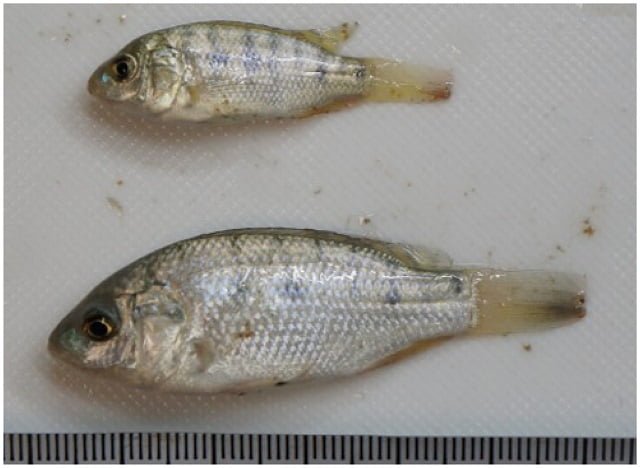
Selective breeding has been the preferred method of obtaining fast-growing genetic lines of fish. However, these methods are expensive and time consuming.
On the other hand, genetic modification and genome editing techniques have a potential risk for wild populations. Therefore, methods that do not rely on direct breeding are required to accelerate fish growth.
Methods to accelerate fish growth, such as irradiation of fish with light of specific wavelength and control of water temperature, have recently been proposed. However, these technologies are expensive and their economic viability has not been evaluated.
The team of researchers from Ehime University set out to develop a technique to accelerate the growth of fish without using genetic modification or genome editing.
They set up a reactor with four pairs of opposing electrodes and a high-voltage power supply for the discharge. An arc discharge generated a plasma-treated gas in the reactor that contained active species such as nitric oxide (NO) and was inserted into an aquarium containing Nile tilapia.
Application of plasma at atmospheric pressure
In recent years, research on the application of atmospheric pressure plasma to the life sciences has been active. Studies on antitumor effects, blood clotting, wound healing, and the delivery of genes and molecules to cells have been reported.
In addition, there are reports on the effects of plasma treatment in fish; however, no cases of changes in growth rate have been reported.
Supply of chemically active species
Supply of chemically active species to water tanks has been studied as a growth acceleration method that does not require large-scale facilities.
One investigation reports that the length and weight of goldfish doubled and quadrupled, respectively, when ozone was supplied to an aquarium, compared to individuals who did not receive ozone.
However, there is also a report that indicates the opposite, as is the case of the use of ozone in culture tanks of char (Salvelinus leucomaenis) that caused abnormal red blood cells and the death of the fish due to acute toxicity.
A candidate active species other than ozone is nitric oxide (NO). Research reports that nitric oxide exhibits wound healing effects.
Plasma treated gas supply
The researchers supplied plasma-treated gas to the 20-liter tank, at a flow rate of 10 L per minute for variable delivery times. The duration of the supply of plasma-treated air to the water tank was 0.5, 2, 5 and 15 minutes.
They prepared tanks for each of these four conditions and gas was supplied daily at the same time.
Effect of plasma treated gas
“We observed that by supplying tilapia with plasma-treated gas from 16 weeks of age for 5 minutes daily, the average length of the fish at 31 weeks of age was approximately 1.5 times greater than that of control fish,” the researchers report.
They also found that all other delivery time conditions increased acceleration over control.
“For the 15-min feed, which was the longest feed duration, the fish body length variation was most significant after 21 weeks of age,” they noted.
Conclusion
“The results suggest that an excessive supply of active species can lead to growth inhibition. These results suggest that an optimal supply of plasma-treated gas has a growth-promoting effect on fish,” they conclude.
According to the researchers, the most outstanding results of the study are:
- An increase in the growth rate of the samples that were supplied gas treated with plasma was observed after 21 weeks of age.
- Before the age of 21 weeks, when the specimens had a shorter body length, the average growth rate of the specimens not treated with plasma (control) was high, while that of the specimens that received gas treated with plasma was deleted.
- The maximum increase in body length up to 31 weeks of age occurred within 5 min of feeding time and a cumulative NO supply of 6.0 mg, increasing body length by 64.6 mm. This was >53% over the 42.2mm increase in length from the control.
- The average growth rate at 31 weeks of age in the 5 min supply time was the highest of the growth rates evaluated in this document (1.1 mm/day).
The study was funded by the New Energy and Industrial Technology Development Organization (NEDO) and the Shikoku Electric Power Company.
Contact
Yoshihisa Ikedaa
Department of Electrical and Electronic Engineering,
Ehime University,
Matsuyama, Japan
Email: yikeda@mayu.ee.ehime-u.ac.jp
Reference (open access)
Yoshihisa Ikeda, Ryo Fukushima, Kazuki Tange, Hideki Motomura, Taiju Saito & Masafumi Jinno (2023) Growth acceleration of Nile tilapia at 21 to 31 weeks of age with plasma-treated air-supplied water, Free Radical Research, DOI: 10.1080/10715762.2023.2185124
Editor at the digital magazine AquaHoy. He holds a degree in Aquaculture Biology from the National University of Santa (UNS) and a Master’s degree in Science and Innovation Management from the Polytechnic University of Valencia, with postgraduate diplomas in Business Innovation and Innovation Management. He possesses extensive experience in the aquaculture and fisheries sector, having led the Fisheries Innovation Unit of the National Program for Innovation in Fisheries and Aquaculture (PNIPA). He has served as a senior consultant in technology watch, an innovation project formulator and advisor, and a lecturer at UNS. He is a member of the Peruvian College of Biologists and was recognized by the World Aquaculture Society (WAS) in 2016 for his contribution to aquaculture.
